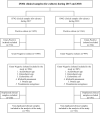Evaluating the Prevalence and the Risk Factors of Gram-Negative Multi-Drug Resistant Bacteria in Eastern Saudi Arabia
- PMID: 35210791
- PMCID: PMC8860351
- DOI: 10.2147/IDR.S350048
Evaluating the Prevalence and the Risk Factors of Gram-Negative Multi-Drug Resistant Bacteria in Eastern Saudi Arabia
Abstract
Purpose: Multidrug-resistant organisms (MDROs) among Gram-negative bacteria (GNB) are a major public health concern worldwide, which can even lead to death. This study was conducted to determine the prevalence of MDROs among isolated GNB in the Security Forces Hospital Dammam (SFHD) and identify its associated risk factors.
Materials and methods: A cross-sectional study was performed on the most commonly isolated GNB in SFHD, Acinetobacter spp., Enterobacter spp., Escherichia coli (E. coli), Klebsiella pneumoniae, Proteus spp., and Pseudomonas aeruginosa, of non-duplicated clinical samples collected from all hospital units throughout the period from January 2017 to December 2018. Data were collected retrospectively from patients' medical records, and analyses were conducted using the chi-square test and logistic regression models.
Results: Of the 1508 GNB included in the study, 969 were multidrug-resistant (MDR; 64.3%). The most commonly identified multidrug-resistant GNB (MDR-GNB) were found in female patients (66.4%) and those aged between 20 and 29 years (21.8%). Urine samples had the highest number of isolated GNB (926 of a total of 1508, 61.4%), and E. coli isolates (53.8%) were the most frequently isolated GNB. Enterobacter spp. had the highest rate of multidrug resistance during the 2 years (64 out of 74, 86.5%). Mechanical ventilation for three or more calendar days was a significant direct risk factor for the development of MDR-GNB (odds ratio [OR]: 2.600, 95% confidence interval [CI]: 1.124-6.012, P = 0.025).
Conclusion: Multidrug resistance is common among GNBs in SFHD. Antimicrobial stewardship programs in hospitals should be supported and implemented. Medical and public awareness of antibiotic use is another significant way to decrease the burden of MDR.
Keywords: antimicrobial resistance; hospital-acquired pathogens; infectious diseases.
© 2022 Al Hamdan et al.
Conflict of interest statement
The authors declare that they have no competing interests in this work.
Figures


References
-
- Hall KK, Shoemaker-Hunt S, Hoffman L, et al. Making healthcare safer iii: a critical analysis of existing and emerging patient safety practices. Agency for Healthcare Research and Quality (US); 2020. Available from: https://www.ncbi.nlm.nih.gov/books/NBK555533/. Accessed February 4, 2022. - PubMed
-
- Antimicrobial resistance: tackling a crisis for the health and wealth of nations. London: Wellcome Trust; 2014.
LinkOut - more resources
Full Text Sources
Molecular Biology Databases
Miscellaneous

